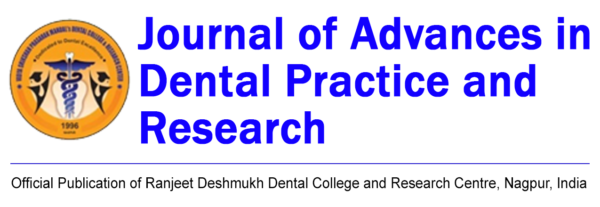Translate this page into:
The etiology of temporomandibular disorders: Are we missing something?
*Corresponding author: Saee Deshpande, Professor, Department of Prosthodontics, Ranjeet Deshmukh Dental College and Research Center, Nagpur, Maharashtra, India.saeedeshmukh@vspmdcrc.edu.in
-
Received: ,
Accepted: ,
How to cite this article: Deshpande S. The etiology of temporomandibular disorders: Are we missing something?. J Adv Dental Pract Res. 2023;2:33. doi: 10.25259/JADPR_4_2024
Temporomandibular disorders (TMDs)[1] are conditionsproducing abnormal, incomplete, or impaired function of the temporomandibular joint(s) (TMJs) and/or the muscles of mastication; they have a multifactorial etiology, encompass a wide spectrum of conditions, and are essentially characterized by the appearance of pain, joint sounds, and alterations in mandibular movement.[2]
TMDs are a significant public health problem affecting approximately 5–12% of the overall population, being considered the most common cause of chronic pain of non-dental origin in the orofacial area.[3] The prevalence rate in Indian population is reported to be 17–53%, and 15–20% of the patients actively seek treatment.[4]
Identifying etiological factors and their relation to type and severity of the disease can lead to better treatment planning and predictable outcomes in TMD patients.
It has been linked to several systemic and stomatognathic factors such as para-function, occlusion, stress, trauma, prosthetic status and unmet treatment need, sleep apnea, and bruxism, and their association varies in different populations.[5-7]
Most recently, it has been postulated that pain in TMDs is more centrally mediated and is affected by all factors that mediate chronic pain.
Ma et al.[8] investigated the involvement of gut microbiota in the development of TMJ inflammation and concluded that resveratrol alleviates TMJ inflammatory pain by recovering disturbed gut microbiota.
Lassmann et al.[9] in his classic review article have discussed in depth the roles of the gut microbiota, sleep, and melatonin in chronic orofacial pain and depression. The key findings from his review are first inflammation that has an adverse effect on the sleep-wake cycle, resulting in increased susceptibility to pain, anxiety, and stress, as well as intestinal permeability and disturbed microbiota; second, bacterial dysbiosis sensitizes the central nervous system (both directly and indirectly), which may be a factor in many forms of chronic pain; third, the gut microbiome’s disturbance and inflammation affect how serotonin and melatonin are metabolized; and finally, females are more predisposed to gastroesophageal reflux disease, irritable bowel syndrome, sleep disorders, anxiety, depression, post-traumatic stress disorder, hyperalgesia, and somatization.
Therefore, as a treating dentist, we should be aware that not only dental factors such as occlusion and parafunction but also other factors such as gender-related hormones, gut health, and sleep influence TMDs. The treatment should be started only after a thorough history including all these factors and directed toward solving the root cause rather than symptomatic relief.
References
- The glossary of prosthodontic terms: Ninth edition. In: J Prosthet Dent. Vol 117. 2017. p. :e1-105.
- [CrossRef] [Google Scholar]
- The management of temporomandibular disorders and occlusion (7th ed). St. Louis: Elsevier Mosby; 2013. p. :109-12.
- [Google Scholar]
- Prevalence of temporomandibular joint disorders: A systematic review and meta-analysis. Clin Oral Investig. 2021;25:441-53.
- [CrossRef] [PubMed] [Google Scholar]
- Prevalence of temporomandibular disorders in Chennai population. J Indian Acad Oral Med Radiol. 2015;27:508-15.
- [CrossRef] [Google Scholar]
- Association between symptoms of temporomandibular disorders and gender, morphological occlusion, and psychological factors in a group of university students. Indian J Dent Res. 2009;20:190.
- [CrossRef] [PubMed] [Google Scholar]
- Temporomandibular disorders, sleep bruxism, and primary headaches are mutually associated. J Orofac Pain. 2013;27:14-20.
- [Google Scholar]
- Correlation between posterior edentulousness and temporomandibular disorder in adult population: A case control study. IAIM. 2017;4:143-50.
- [Google Scholar]
- Resveratrol alleviates temporomandibular joint inflammatory pain by recovering disturbed gut microbiota. Brain Behav Immun. 2020;87:455-64.
- [CrossRef] [PubMed] [Google Scholar]
- Gut bless your pain-roles of the gut microbiota, sleep, and melatonin in chronic orofacial pain and depression. Biomedicines. 2022;10:1528.
- [CrossRef] [PubMed] [Google Scholar]





